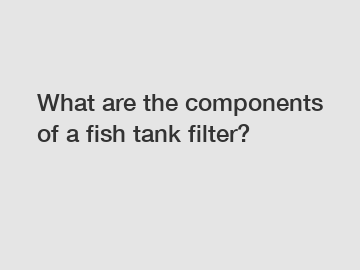Feb. 20, 2024
Agriculture
Having a fish tank in your home can bring a sense of tranquility and beauty to any room. However, maintaining a fish tank requires more than just feeding the fish and changing the water. One of the most important components of a fish tank is the filter. A fish tank filter helps to keep the water clean and healthy for your fish by removing harmful toxins and excess waste. In this article, we will discuss the different components of a fish tank filter and why they are important for the overall health of your fish.
1. Mechanical Filtration:
One of the main components of a fish tank filter is mechanical filtration. This type of filtration involves physically removing particles and debris from the water. Mechanical filters usually consist of a sponge or floss that traps debris as the water passes through. This helps to prevent the build-up of waste in the tank and keeps the water clear and clean for your fish to thrive.

2. Biological Filtration:
Biological filtration is another essential component of a fish tank filter. This type of filtration utilizes beneficial bacteria to break down harmful toxins such as ammonia and nitrites that are produced by fish waste and uneaten food. These bacteria convert these toxins into less harmful substances, such as nitrates, which are then removed from the water through regular water changes. Having a strong biological filter in your tank is crucial for maintaining a healthy and stable environment for your fish.
3. Chemical Filtration:
Some fish tank filters also include a chemical filtration component. This type of filtration uses activated carbon or other chemical media to remove impurities and odors from the water. Chemical filtration can help to improve water clarity and remove substances that may be harmful to your fish. However, it is important to use chemical filtration sparingly as it can also remove beneficial nutrients and trace elements from the water.
4. UV Sterilization:
Some advanced fish tank filters may also include a UV sterilization component. UV sterilizers use ultraviolet light to kill harmful bacteria and pathogens in the water, helping to prevent diseases and keep your fish healthy. UV sterilization is particularly useful in larger tanks or tanks with a high fish population where the risk of diseases spreading is higher.
5. Water Flow:
In addition to the filtration components, the water flow in your fish tank filter is also important. A strong and consistent water flow helps to distribute the filtered water evenly throughout the tank, ensuring that all areas receive proper filtration and oxygenation. It also helps to prevent stagnant areas where debris can accumulate and water quality can deteriorate. When choosing a fish tank filter, make sure to consider the size of your tank and the flow rate needed to maintain a healthy environment for your fish.
In conclusion, a fish tank filter is a crucial component of any aquarium setup. It helps to maintain water quality, remove harmful toxins, and provide a healthy environment for your fish to thrive. By understanding the different components of a fish tank filter and how they work together, you can ensure that your fish tank remains clean and healthy for years to come. Remember to regularly maintain and clean your filter to ensure optimal performance and the well-being of your fish. Happy fishkeeping!
Want more information on ceramic rings aquarium, air sponge filter, fish tank ceramic rings? Feel free to contact us.
Previous: How long does HDPE last?
Next: Ultimate Guide to Potassium Fertilizer: Benefits, Application, and Tips
If you are interested in sending in a Guest Blogger Submission,welcome to write for us!
All Comments ( 0 )